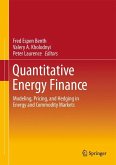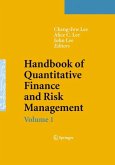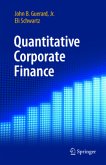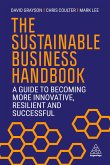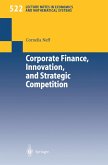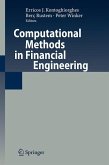Handbook of Quantitative Sustainable Finance
Herausgeber: Tankov, Peter; Zhang, Ruixun
Handbook of Quantitative Sustainable Finance
Herausgeber: Tankov, Peter; Zhang, Ruixun
- Gebundenes Buch
- Merkliste
- Auf die Merkliste
- Bewerten Bewerten
- Teilen
- Produkt teilen
- Produkterinnerung
- Produkterinnerung
Handbook of Quantitative Sustainable Finance is an edited collection concerning the integration of sustainability and climate risk considerations into mathematical and quantitative finance.
Andere Kunden interessierten sich auch für
![Quantitative Energy Finance Quantitative Energy Finance]() Quantitative Energy Finance151,99 €
Quantitative Energy Finance151,99 €![Handbook of Quantitative Finance and Risk Management Handbook of Quantitative Finance and Risk Management]() Cheng-Few Lee / Alice C. Lee / John Lee (Hrsg.)Handbook of Quantitative Finance and Risk Management725,99 €
Cheng-Few Lee / Alice C. Lee / John Lee (Hrsg.)Handbook of Quantitative Finance and Risk Management725,99 €![Ethics in Quantitative Finance Ethics in Quantitative Finance]() Timothy JohnsonEthics in Quantitative Finance34,99 €
Timothy JohnsonEthics in Quantitative Finance34,99 €![Quantitative Corporate Finance Quantitative Corporate Finance]() John B. GuerardQuantitative Corporate Finance115,99 €
John B. GuerardQuantitative Corporate Finance115,99 €![Sustainable Business Handbook Sustainable Business Handbook]() David GraysonSustainable Business Handbook45,99 €
David GraysonSustainable Business Handbook45,99 €![Corporate Finance, Innovation, and Strategic Competition Corporate Finance, Innovation, and Strategic Competition]() Cornelia NeffCorporate Finance, Innovation, and Strategic Competition77,99 €
Cornelia NeffCorporate Finance, Innovation, and Strategic Competition77,99 €![Computational Methods in Financial Engineering Computational Methods in Financial Engineering]() Computational Methods in Financial Engineering76,99 €
Computational Methods in Financial Engineering76,99 €-
-
-
Handbook of Quantitative Sustainable Finance is an edited collection concerning the integration of sustainability and climate risk considerations into mathematical and quantitative finance.
Produktdetails
- Produktdetails
- Verlag: Taylor & Francis Ltd
- Seitenzahl: 498
- Erscheinungstermin: 12. Dezember 2025
- Englisch
- Abmessung: 254mm x 178mm
- Gewicht: 1110g
- ISBN-13: 9781032627922
- ISBN-10: 1032627921
- Artikelnr.: 74438235
- Herstellerkennzeichnung
- Libri GmbH
- Europaallee 1
- 36244 Bad Hersfeld
- gpsr@libri.de
- Verlag: Taylor & Francis Ltd
- Seitenzahl: 498
- Erscheinungstermin: 12. Dezember 2025
- Englisch
- Abmessung: 254mm x 178mm
- Gewicht: 1110g
- ISBN-13: 9781032627922
- ISBN-10: 1032627921
- Artikelnr.: 74438235
- Herstellerkennzeichnung
- Libri GmbH
- Europaallee 1
- 36244 Bad Hersfeld
- gpsr@libri.de
Peter Tankov is professor of quantitative finance at ENSAE, the French National School for Statistics and Economic Administration, having previously worked at Paris-Cite university and Ecole Polytechnique. He is a mathematician, specialist in applied probability and quantitative finance. He earned his PhD in applied mathematics from Ecole Polytechnique in 2004. His current research focuses on green and sustainable finance, where he aims to develop quantitative methodologies. Peter is the author of over 60 research articles on these and other topics and of the widely read book, Financial Modelling with Jump Processes. He is the recipient of the 2016 Best Young Researcher in Finance award of the Europlace Institute of Finance and the 2024 Louis Bachelier Prize of London Mathematical Society, SMAI, and Natixis Foundation. Professor Tankov is the scientific director of the Paris Agreement Research Commons foundation at Louis Bachelier Institute, where he leads data-oriented initiatives, and member of editorial boards of the main quantitative finance journals: Mathematical Finance and Finance and Stochastics. Ruixun Zhang is an associate professor with tenure at Peking University. Ruixun earned a PhD in Applied Mathematics from MIT in 2015, and bachelor's degrees in Mathematics and Applied Mathematics, and Economics (double degree) from Peking University in 2011. Ruixun's research interests include green finance, machine learning, market microstructure, and evolutionary models of financial behavior. His research has appeared in leading journals such as Proceedings of the National Academy of Sciences, Operations Research, Management Science, and Journal of the American Statistical Association. His work has been recognized by the S&P Global Academic ESG Research Award, the International Centre for Pension Management (ICPM) Research Award, the Commodity and Energy Markets Association (CEMA) Questrom-CEMA Best Paper Prize, the SIAM Activity Group on Financial Mathematics and Engineering Conference Paper Prize, and the CFRI&CIRF-China Finance Review International Research Excellence Award. He serves on the editorial board of Digital Finance and International Journal of Financial Engineering.
1 Introduction: what can quantitative finance bring to sustainable finance?
I Risks and Regulation 2 Transition risks: a new frontier for risk
management 3 Green investment and asset stranding under transition scenario
uncertainty 4 Climate stress testing 5 Combating climate change with green
quantitative easing II Asset Pricing and Portfolio Management 6 Dissecting
green returns 7 Climate impact investing 8 Quantifying the impact of impact
investing 9 Performance attribution for portfolio constraints 10 Portfolio
alignment and net zero investing III Data, Measurement, and AI 11 Data for
climate and sustainable finance 12 Estimating corporate greenhouse gas
emissions 13 Measurement of firm climate risks 14 ESG scores to the rescue:
objectives, procedures, and uses IV Product Design and Specific Markets 15
The value of green energy: optimal investment in mutually exclusive
projects and operating leverage 16 The effect of pro-environmental
preferences on bond prices: Evidence from green bonds 17 Stochastic carbon
regulation in continuous time 18 Insurance products and sustainability
I Risks and Regulation 2 Transition risks: a new frontier for risk
management 3 Green investment and asset stranding under transition scenario
uncertainty 4 Climate stress testing 5 Combating climate change with green
quantitative easing II Asset Pricing and Portfolio Management 6 Dissecting
green returns 7 Climate impact investing 8 Quantifying the impact of impact
investing 9 Performance attribution for portfolio constraints 10 Portfolio
alignment and net zero investing III Data, Measurement, and AI 11 Data for
climate and sustainable finance 12 Estimating corporate greenhouse gas
emissions 13 Measurement of firm climate risks 14 ESG scores to the rescue:
objectives, procedures, and uses IV Product Design and Specific Markets 15
The value of green energy: optimal investment in mutually exclusive
projects and operating leverage 16 The effect of pro-environmental
preferences on bond prices: Evidence from green bonds 17 Stochastic carbon
regulation in continuous time 18 Insurance products and sustainability
1 Introduction: what can quantitative finance bring to sustainable finance?
I Risks and Regulation 2 Transition risks: a new frontier for risk
management 3 Green investment and asset stranding under transition scenario
uncertainty 4 Climate stress testing 5 Combating climate change with green
quantitative easing II Asset Pricing and Portfolio Management 6 Dissecting
green returns 7 Climate impact investing 8 Quantifying the impact of impact
investing 9 Performance attribution for portfolio constraints 10 Portfolio
alignment and net zero investing III Data, Measurement, and AI 11 Data for
climate and sustainable finance 12 Estimating corporate greenhouse gas
emissions 13 Measurement of firm climate risks 14 ESG scores to the rescue:
objectives, procedures, and uses IV Product Design and Specific Markets 15
The value of green energy: optimal investment in mutually exclusive
projects and operating leverage 16 The effect of pro-environmental
preferences on bond prices: Evidence from green bonds 17 Stochastic carbon
regulation in continuous time 18 Insurance products and sustainability
I Risks and Regulation 2 Transition risks: a new frontier for risk
management 3 Green investment and asset stranding under transition scenario
uncertainty 4 Climate stress testing 5 Combating climate change with green
quantitative easing II Asset Pricing and Portfolio Management 6 Dissecting
green returns 7 Climate impact investing 8 Quantifying the impact of impact
investing 9 Performance attribution for portfolio constraints 10 Portfolio
alignment and net zero investing III Data, Measurement, and AI 11 Data for
climate and sustainable finance 12 Estimating corporate greenhouse gas
emissions 13 Measurement of firm climate risks 14 ESG scores to the rescue:
objectives, procedures, and uses IV Product Design and Specific Markets 15
The value of green energy: optimal investment in mutually exclusive
projects and operating leverage 16 The effect of pro-environmental
preferences on bond prices: Evidence from green bonds 17 Stochastic carbon
regulation in continuous time 18 Insurance products and sustainability


